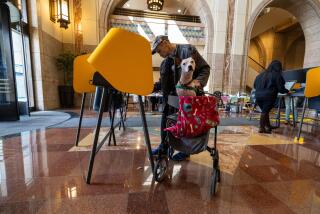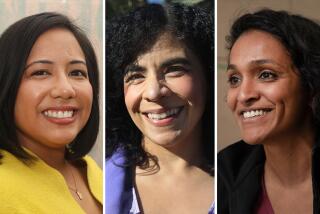Decision ’93 / A Look at the Elections in Los Angeles County : The L.A. Vote : Shaping Things to Come? : A Troubled City Faces A Maze of Issues and Many Candidates in a Turning-point Election
- Share via
Los Angeles is a troubled city looking for hope as its residents await the first wide-open mayoral election since Tom Bradley won the office 20 years ago.
Twenty-four candidates are running, so many that voters have had to be detectives to sort out their messages and get a sense of their characters. The sheer number makes it all but impossible for anyone to win a majority on Election Day, April 20. That means the top two candidates will probably compete in a runoff June 8.
The arrival of a new mayor by itself would make this a turning point in the city’s history, probably the most important election since Fletcher Bowron overturned the corrupt Frank Shaw Administration in the late 1930s.
That election did much to shape L.A.’s present city government. This one may, too. Two measures on the ballot would limit officeholders to two terms, ending the possibility of another two-decade mayoralty and breaking the stranglehold most incumbents have on city offices.
In addition, eight City Council seats are on the ballot, two of them in open districts with no incumbents. That guarantees more change. Finally, three Los Angeles Unified School District board seats and three on the community colleges board are before the voters.
As important as they are, the ballot measures, the council contests and the races for education posts are just background music for the main act, the race for mayor.
For the mayor is the center of L.A. city government and the single most-visible elected official in Southern California. The mayor has the all-important job of writing the city budget--and dealing this year with a possible deficit of up to $550 million. The mayor appoints the boards and commissions that shape city departments’ policies. And the mayor, more than any other official, is the voice of L.A.
The obstacles facing the new mayor are far greater than those that confronted Bradley in 1973.
Then, as now, racial tensions afflict the metropolis, which was still reeling from the 1965 Watts riots. But last spring’s rioting exceeded Watts in deaths, scope and monetary loss. And recovery will be much more difficult, impeded by the worst economic slump since the Great Depression, and problems either little known or undreamed of in the 1970s.
Among them are homelessness, illegal immigration and schools packed with children who speak many languages. The schools and the streets are scenes of violence rarely seen in the 1970s. Diseases once thought to be conquered--measles and tuberculosis among them--rage through slums that did not exist when Bradley took office. Another disease with vast implications for the city, AIDS, was not even known the day Bradley was sworn in.
Race relations are much more difficult today. In 1973, race in L.A. was pretty much a matter of blacks, whites and Latinos, most of whom were of Mexican descent. Today’s mix is more volatile and complex, as the riots showed.
Although some of these problems are outside City Hall’s jurisdiction, the new mayor won’t be able to avoid them. When gunfire erupts in the schools, for example, L.A. police respond.
The candidates have been offering their prescriptions since the campaign began in earnest earlier this year. But despite the magnitude of the city’s afflictions, and its clear need for guidance and leadership, the candidates’ solutions tended to be vague.
To be fair to them, the field has been cluttered with too many candidates for a satisfactory exchange of views. All that anyone needed to enter the race were 500 signatures on a petition and a $300 filing fee. Those without money could jump in with 1,000 signatures. And candidates who raised $10,000 for a campaign were entitled to matching funds from the city treasury. Bored? Lonely? Run for mayor.
But toward the end of the campaign, it was possible to separate the candidates in broad categories.
The Private Enterprise Candidates offer the greatest change. Republican businessman-attorney Richard Riordan is the most radical, accepting many of the proposals long offered by the Reason Foundation, a conservative think tank in Santa Monica. He proposes turning over Los Angeles International Airport to private operators and having private companies collect the garbage. A more liberal Democrat, Assemblyman Richard Katz, is another strong advocate of the private enterprise approach, proposing the sale of Los Angeles International Airport and the city airport in Ontario.
There are Transportation Candidates. These have added up the billions of dollars coming to Los Angeles County for various rail, surface street and freeway transportation projects in the next few years, and proposed spending it to create industrial, technical and construction jobs. Transit board member Nick Patsaouras is a prime advocate of this approach, as is Katz.
The Restructuring Candidates propose digging deep into City Hall and rearranging government. A consensus exists among a substantial number of candidates to eliminate departments, such as the Board of Public Works. A more far-reaching approach comes from Councilman Joel Wachs, who proposes creation of citizen councils in more than 100 neighborhoods with decision-making power over budgeting, planning and other issues. Councilman Ernani Bernardi proposes dismantling the Community Redevelopment Agency.
Others, more in the style of Mayor Bradley, support the present government structure, although promising to infuse it with new energy. Councilman Michael Woo has built his campaign around this, and is selling himself as a Bradley-style consensus-builder.
It is a bewildering choice of candidates and proposals. From them, Angelenos must choose a mayor to lead them to a better day.
More to Read
Sign up for Essential California
The most important California stories and recommendations in your inbox every morning.
You may occasionally receive promotional content from the Los Angeles Times.










